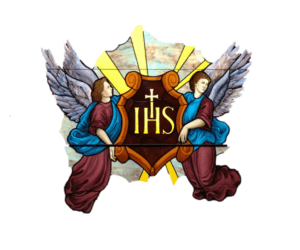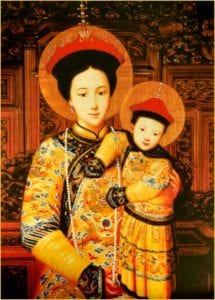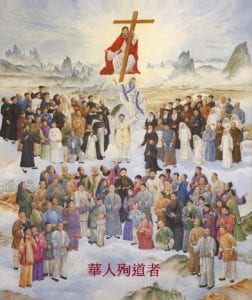In addition to Chinese New Year, the Holy Name of Jesus Chinese Catholic Mission celebrates three other feast days annually: the Holy Name of Jesus, Our Lady of China and the Holy Martyrs of China. The Chinese community celebrates these feast days with a special Mass, and Archbishop Gregory J. Hartmayer, OFM CONV. has given permission for the Chinese community to celebrate these feast days on the nearest Sunday of Ordinary Time.
 The Most Holy Name of Jesus
The Most Holy Name of Jesus
The Feast Day of the Most Holy Name of Jesus is on January 3. It is the principal Feast Day of our church. The abbreviation of IHΣΟΥΣ, the Greek for ‘Jesus’, in the form ΙΗΣ appears in manuscripts from the second century, but it was in the Middle Ages that devotion to the Holy Name of Jesus became widespread. St. Anselm (1033-1109 AD) wrote a very popular “Prayer to the Name of Jesus”. St. Bernard of Clairvaux (1090-1153 AD) preached a famous sermon in which he described the Holy Name as a balm which has three qualities: healing, nourishing and illuminating. It was in the 15th century that St. Bernardine of Siena (1380-1444) created a new impetus for the devotion. At the end of his sermons, he would display a tablet bearing the letters of the Holy Name in gold. Pope Martin V (1369-1431 AD) endorsed the devotion to the Holy Name of Jesus. In the 16th century, the Society of Jesus made the IHS monogram their emblem.
 Our Lady of China
Our Lady of China
The day before Mother’s Day is also the feast day of Our Lady of China, the name given to Mary when she appeared to God’s beloved children in Donglu, China in 1900: “…A woman in white appeared above the settlement, and the rioters’ bullets were aimed at her. When the apparition did not fade, attackers had not even time to reorganize because a strange horseman put them to flight.” The Mother of Christ appeared in China showing herself as the protector and defender for helpless and the righteous. Mary hopes for a China that could become a shiny beacon of light, a nation where the family is valued, where all Life is protected and the Chinese people have the right to freely worship the great God Almighty.
Soon after they had disappeared beyond the horizon, Father Wu, a Chinese priest, confessed to his flock that he invoked the help of Mary. A new church was built on the site and Father Wu placed a picture of Our Lady on the main altar. He asked the painter to dress Our Lady in the royal robes of the dowager Empress Tzi-Hsi. The image of the Blessed Virgin in the royal robes of the pagan Empress, with the Christ Child on her knees, is vivid expression of Chinese tradition. It is a shrine of the Mother and her Son. Though her robes are pagan, she belongs to every age, to all people and to every race.
An officially-sanctioned image of Our Lady of China was blessed, granted and promulgated by Pope Pius XI in 1928, in response to the requests made by the 1924 Shanghai Synod of Bishops in China, the first national conference of bishops in the country. Following the event, Archbishop Celso Costantini, Apostolic Delegate in China, along with all the bishops of China, declared the Chinese people dedicated to Our Lady of China, using the official image. In 1941, Pope Pius XII designated the feast day of Our Lady of China as an official feast day in the Catholic liturgical calendar. In 1973, following the Second Vatican Council, the Chinese Bishops conference, upon approval from the Holy See, placed the feast day on the day before Mother’s Day.
 The Holy Martyrs of China
The Holy Martyrs of China
July 9 is the feast day of the Holy Martyrs of China. There are 120 martyr saints of China from the 17th century to 1930. On October 1, 2000, Pope John Paul II canonized 120 men, women, and children who gave their lives for the faith in China. The martyrs include 87 native Chinese and 33 foreign missionaries. The majority were killed during the Boxer Rebellion of 1900.
Holy Martyrs of China, pray for us!